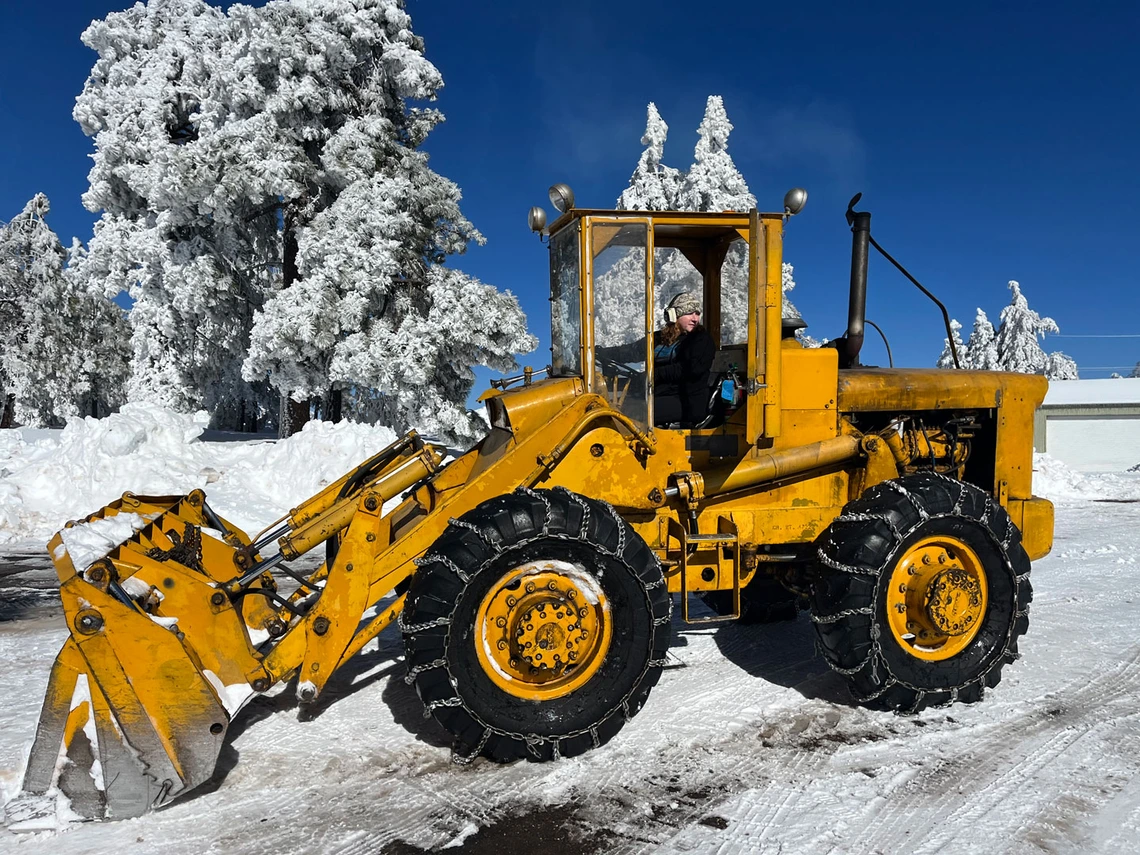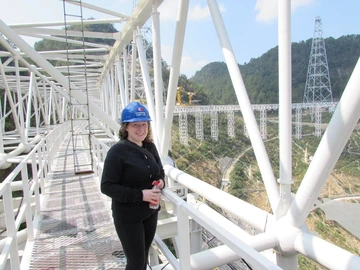Q&A: Maintaining the mountain facilities that fuel the U of A's space science legacy

Trained radio astronomer Alyson Ford is not afraid of climbing into a front loader to clear snow at the Mt. Lemmon SkyCenter observatory when necessary.
Jim Grantham/Steward Observatory
Clear, dark skies and nearby mountaintops are key ingredients in the University of Arizona's worldwide fame as one of the premier destinations for space sciences. Alyson Ford, associate director and associate research professor at the U of A's Steward Observatory, oversees Steward's Mountain Operations and Arizona Radio Observatory groups. She spoke with Lo Que Pasa about what makes her job special.
Several years before the first human set foot on the moon, researchers at the University of Arizona were already busy paving the way for the historic accomplishment. High in the Santa Catalina Mountains, Tucson's very own "Sky Island" mountain range, coveted as a scenic and cool getaway from the summer heat, astronomers were peering through telescopes and mapping the moon's surface.
Since then, more observatories popped up on the mountain, and today, the facilities on Mt. Lemmon and nearby Mt. Bigelow enjoy worldwide renown as some of the finest astronomy sites in North America. In close collaboration with partners both on campus and across the world, the U of A Steward Observatory operates and manages its facilities under a permit agreement with the U.S. Forest Service, which it's seeking to renew for the next 10 years. The public is invited to learn about and provide input on a proposed Master Development Plan outlining the existing facilities and future projects and improvements.
Can you tell us about your role as associate director of Steward Observatory?
I spend most of my time overseeing our various observatories and facilities, including those in the Catalina Mountains, where we have two distinct telescope sites, one on Mt. Lemmon and the other on Mt. Bigelow, U of A's radio and optical telescope sites on Kitt Peak, a radio and optical telescope on Mount Graham, the Sunnyside Mirror Aluminizing facility in South Tucson, and several labs here at Steward. I oversee a team of engineers, technicians, telescope operators and others who support all of those facilities, all in all about 45 people. A lot of my work involves collaborating with other university units such as Facilities Management and Planning, Risk Management and Research Laboratory & Safety Services, in addition to faculty, students and external stakeholders.

Ford says she "cares very much about the electromagnetic spectrum and policies ensuring astronomers can continue to observe radio signals with minimal interference from radio communications such as cell phones, Wi-Fi and satellites." Here she is pictured visiting the Five-hundred-meter Aperture Spherical radio Telescope (FAST) in Guizhou, China.
John Ford
How does your team feel about their work?
Many of our staff members tell me they love the variety of what they do. There's always something new, something different happening, and you never know what you're going to be working on. You can plan for things, but things happen that you don't plan for. Whether a new instrument is being developed, a camera needs to be repaired, or we need to aluminize (recoat) a mirror, there's always something new and interesting happening. And of course we have to keep everything running on a day-to-day basis. We even have our own custodial team. One of our managers likes to joke, 'from toilets to telescopes' – we take care of it all. We have several partnerships with other universities, and some have telescopes on Mt. Lemmon that we maintain under service agreements. Even during times when we're not observing, there is an enormous amount of work happening because that's when we have time to do all those big maintenance and upgrade projects.

Mt. Lemmon SkyCenter observatory domes at sunset.
David Rankin
What makes working at these mountain facilities special?
It is a very unique environment, not just because of the altitude. We have wildlife everywhere up there, from scorpions and centipedes to bears to mountain lions. Just today, someone sent me a picture of a beautiful Arizona black rattlesnake on Mt. Bigelow. We definitely tend to attract people who enjoy the outdoors, even if that means they'll need to be up there in the middle of the winter and potentially during storms. Our staff have to be ready for anything. In the winter, many need to be able to operate snowplows, while others have to be fall-protection certified or know how to handle large mirrors and chemicals safely. Our employees tend to be skilled at a variety of things, because they have to be self-sufficient and come up with solutions on their own. There's no hardware store on the top of the mountain. It's a really fun group. They love what they do, and they are up for adventure.
What role do the mountaintop facilities play in the university's role in space exploration?
They are critical, not only for research, but for education and public outreach as well. For example, the Kuiper 61-inch telescope, the largest that we have in the Catalinas, is on Mt. Bigelow. It is used by the astronomical community at large, based on a peer review process where scientists apply for observing time, including by the Catalina Sky Survey (CSS, a NASA-funded program to detect potentially hazardous near-Earth asteroids). It is also used for undergraduate courses and astronomy summer camp programs, where students and camp participants get an opportunity for hands-on observing. Our Mt. Lemmon site is also in high demand, from astronomers to K-12 school groups in the SkySchool program and the general public as part of our SkyNights and day tour programs. In this day and age, not many people have the opportunity to look through an eyepiece of a 32-inch telescope and see cosmic objects like Saturn with its rings or nebula. It’s a rare opportunity, and we provide that.
What does the collaboration with the U.S. Forest Service look like?
We work very closely with them. For example, we coordinate with them to ensure that activities we're doing don't conflict with, say, spotted owl mating season. They keep us in the loop when there are fires in the area – whether it's prescribed burns or wildfires. When we want to do telecommunications or facilities upgrades, special forms need to be filled out and a process of approvals has to be followed. Plus, quite a few buildings up there belong to the Forest Service, including those where we do a lot of the education and public outreach, which we are able to use through our permit with them. It’s a really great partnership.
Why is it important for the U of A to maintain a presence on the mountain?
There are several outstanding programs happening right now, not just the ongoing collaborations with the broader astronomy research community and the Catalina Sky Survey work, but also very unique educational and outreach programs that you can't get anywhere else. For example, people travel from all over to attend the teen and adult Astronomy Camps, and the SkySchool and SkyNights programs provide such a unique opportunity for school kids and the public. Given the high elevation, this site is excellent for future telescopes as well, and we're currently working towards installing three new radio telescopes and a 2-meter optical telescope to enhance our research and education activities. I think the U of A makes great use of these facilities by ensuring access to a variety of groups for a wide array of activities. In the future, we would like to make improvements that would allow our facilities to be even more accessible to the public, such as a visitor center and connections to popular hiking trails.
As part of its continuing partnership with the U.S. Forest Service in the Santa Catalina Mountains, Steward Observatory is in the process of renewing its permit for the next 10 years. Until Sept. 30, the public can learn more about the astronomical facilities on Mt. Lemmon and Mt. Bigelow by visiting the Master Development Plan website, which has a link to the survey for public comment.
Information about tours can be found at the University of Arizona Mount Lemmon SkyCenter website.

